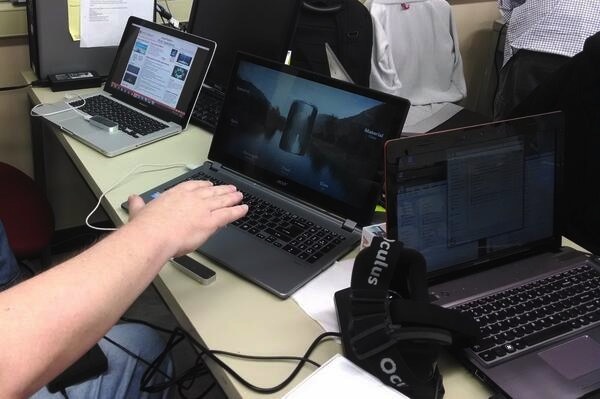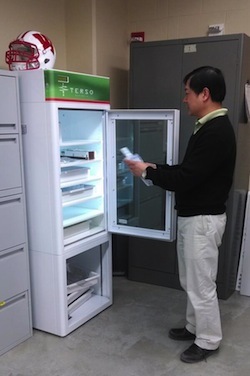The world of networked objects explored

A Leap Motion controller senses a student’s hand gestures to control 3-D modeling in the Internet of Things Lab.
All of us are used to our Internet tethers. Increasingly, however, the inanimate objects we encounter in our daily existence are both smart and wired, and they portend the future.
It is this rapidly evolving world of networked things, where ordinary objects — ranging from our homes and cars to eyeglasses and physiologically, gesture attuned armbands — sense information from the environment or motion, cache it, post it and use it without a human finger touching a keyboard that is the focus of University of Wisconsin–Madison’s Internet of Things (IoT) Lab.
Take, for example, the “magic cabinet” in the IoT lab: Swipe your ID to open and take your pick of the latest technological toys for use in the lab. Without any human action, the cabinet notes the object removed, who has taken it, records the time out and posts it to the web so others who may also wish to use the device can know without setting foot in the lab that it is already in play.
The world, explains IoT Lab co-director Sandra Bradley, is rapidly becoming “hyperconnected,” with more and more devices coming equipped with miniaturized sensors, processors, memory and networking capabilities. “Like all things Internet, the Internet of Things has grown organically. And rapidly.”

Here is a “magic cabinet” in the Internet of Things Lab which helps with laboratory inventory control.
The purpose of the IoT Lab, which holds its first open house on Thursday, May 1, from 5 to 7 p.m., is to provide a setting and the resources for students to explore the technology, experiment, and work as part of a team on projects to exploit the world of networked objects.
Based in the UW–Madison College of Engineering and the Department of Industrial Engineering, the IoT is open to any UW–Madison student and in its first semester has drawn participants from computer science, engineering, communications and business. Students can earn independent credit for work in the lab. Students have also played a key role in equipping the lab by identifying the technologies they would most like to explore.
The IoT Lab also has a serious business side, notes Bradley, who serves, formally, as the research director, retail and consumer applications for the IOT Lab. “We wanted to show Wisconsin companies and others what is on the horizon,” she says, and for students it is an opportunity to perhaps take a project and develop a product, product enhancement or service worthy of commercialization.
“The lab has taken off really well,” Bradley says. “There has been a lot of interest from industry.”
Students work in cross-functional teams and can have projects that build on existing technologies to create something novel. For example, one team is exploring gesture sensitive armbands that can be used for everything from gaming to flying drones, as a means of enhancing the use of American Sign Language in the context of technology.
The upcoming open house, to be held in the Town Center of the Wisconsin Institutes for Discovery, 330 N. Orchard St., will be a showcase for projects with prizes from corporate sponsors Colony Brands, WE Energies and Terso Solutions, a Madison-area radio-frequency identification company.
